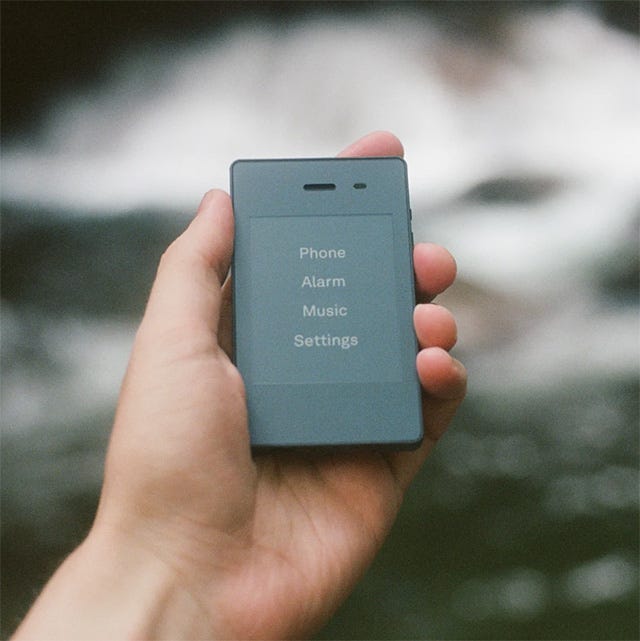Thank you for reading Diapason, where we explore businesses that are pursuing meaningful impact and examine how they do it.
As the commotion of CES in Las Vegas comes to a close, I want to take this opportunity to cast an unconventional light on consumer electronics.
Companies from all corners of the industry are in a frenzy to supercharge humanity. One question plagues everyone’s mind: is there a limit to how smart our devices can be? It’s remarkable how fast we went from trying to build tech that could fit into the palm of our hands to now giving it autonomy to run our lives through “agentic” AI.
It’s truly an exciting time. AI boosts productivity by completing our sentences, removes pesky learning curves in creating images and videos, and soon it will know us better than we know ourselves. While in this AI honeymoon of hyper-connectivity and relentless consumption, I keep wondering: is there a time when we’re meant to just be?
Faster, smarter devices are seamlessly weaved into our life and it’s hard to resist: why not do 100 things at once? To power the beast, however, every eye movement and breath will soon be feeding some algorithm vying for our attention. Already, I’m getting my regular fix of FOMO on Instagram, while doom scrolling the news and feeling the ire of the passive-aggressive Duolingo owl hating me for missing my streak… Is there a time for disconnecting?
Joe Hollier and Kaiwei Tang wondered the same.
When I heard about the Light Phone I think I audibly exhaled. The profoundly simple concept of the product felt like a breath of a fresh air, best told by a snippet from the company’s mission statement:
“Light was founded by Joe Hollier and Kaiwei Tang, an artist and product designer who met in a Google experimental program in 2014. They were encouraged to make smartphone apps and taught on a deeper level how and why different products were being built and funded. It became obvious that the last thing the world needed was another smartphone app fighting for our attention. The interests and nature of these ad-driven platforms will never align with our actual quality of life.”
Yes, Hollier and Tang designed a phone that’s meant to be used as little as possible. Actually, more like as intentionally as possible.
The original Light Phone, funded by a Kickstarter campaign in 2015, could only do calls. A couple of years later the artist/designer duo expanded on the initial offering with Light Phone II, crowdfunding over $3.5M from close to 11,000 backers for the build. This second iteration added a few essential modern-day conveniences: an alarm, a timer, a calculator, directions, a simple music player, notes/voice memo, calendar and a podcasts tool - but all intentionally unassuming. Even the screen was made from “electronic paper”, a technology we know from popular e-readers that does not emit any blue light like traditional backlit screens. This phone is literally built to not draw attention.
Subtlety extended into the branding. The original phone was packaged in a book of photographs. You had to flip through pages of beautiful scenery before getting to the insert with your device, serving as a reminder to never lose sight of the life beyond the screen.


From hardware to software, the company swears by building phones to last. The operating system, LightOS, is custom-designed with a thoughtful and private user experience nowhere near third-party apps. Software updates are released to prolong your device’s life, not coerce you into buying a new one.
Between the first two models, the company has shipped more than 100,000 devices, with the latter accounting for roughly two-thirds of those sales. Now we await the next generation, the Light Phone III, currently on pre-order. This latest version adds a metal frame, USB-C, fingerprint ID, a flashlight, 5G, an NFC chip, and a clickable wheel, as well as a camera - inspired by a more romantic old school point-and-shoot film camera rather than an iPhone.
Not surprisingly, the idea of the Light Phone drew a polarizing response at first. Nevertheless, once the device hit the market, the community around the product vocally embraced the lifestyle, paving the way for some delightfully unconventional PR and collaborators. Among those was something of a social experiment with a private boarding school in Massachusetts, where all students and faculty swapped their smartphones for the Light Phone to reduce distractions on campus. The company also had an exclusive limited-edition "pgLang" branded version of the phone in a campaign with Kendrick Lamar. I have a feeling this is just the beginning for the company.
As I reflect on my technology use over the years, more doesn’t necessarily mean better. I think it’s time we re-examine what makes us human and build technology that can best serve that. In other words, it’s about enriching innovation with an intentionality that comes from a deeper awareness of what makes a fulfilling life, not just what makes something “sticky”. The Light Phone is a nice reminder that tech is supposed to serve us, not the other way around.
Yours,
Val



